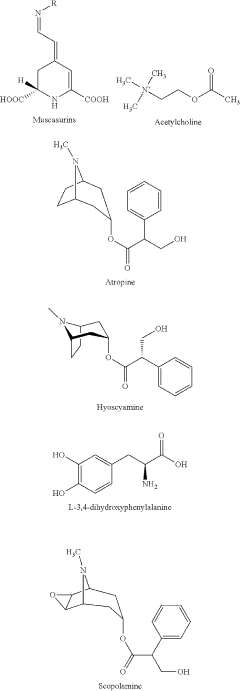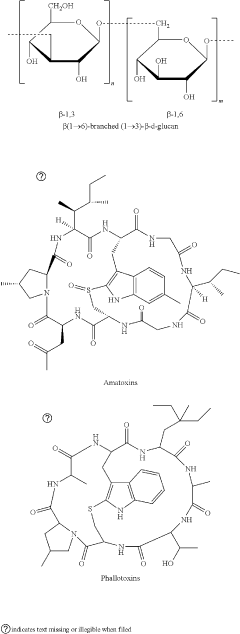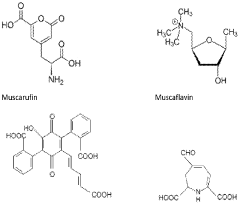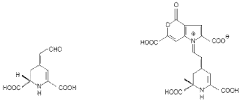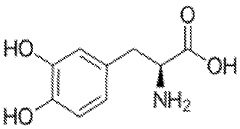Muscimol in the Amphibian Central Nervous System
JUL 4, 20259 MIN READ
Generate Your Research Report Instantly with AI Agent
Patsnap Eureka helps you evaluate technical feasibility & market potential.
Muscimol Research Background and Objectives
Muscimol, a potent GABA receptor agonist, has been a subject of intense research in the field of neuroscience, particularly in the context of amphibian central nervous systems. The study of muscimol's effects on amphibians has provided valuable insights into the functioning of inhibitory neurotransmission and its role in various physiological processes.
The research on muscimol in amphibian central nervous systems dates back to the 1970s when scientists first isolated this compound from the Amanita muscaria mushroom. Since then, it has become a crucial tool for investigating GABAergic signaling mechanisms and their impact on neuronal function. The unique properties of amphibian nervous systems, such as their relatively simple organization and accessibility, have made them ideal models for studying the effects of muscimol.
Over the years, technological advancements have significantly enhanced our ability to explore muscimol's actions at the molecular, cellular, and systems levels. From early electrophysiological recordings to modern optogenetic techniques, researchers have continually refined their approaches to unravel the complexities of muscimol's interactions with GABA receptors in amphibian brains.
The primary objective of muscimol research in amphibian central nervous systems is to elucidate the fundamental principles of inhibitory neurotransmission and its role in regulating neural circuits. This research aims to provide a deeper understanding of how GABAergic signaling modulates various physiological processes, including sensory processing, motor control, and cognitive functions.
Furthermore, studies on muscimol in amphibians have broader implications for understanding similar mechanisms in other vertebrates, including humans. By investigating the effects of muscimol on amphibian nervous systems, researchers hope to gain insights into the evolutionary conservation of GABAergic signaling and its potential therapeutic applications in treating neurological disorders.
Another crucial aspect of this research is to explore the unique adaptations of amphibian nervous systems to their diverse habitats and lifestyles. By studying how muscimol affects different amphibian species, scientists can uncover species-specific variations in GABAergic signaling and their ecological significance.
As we move forward, the field of muscimol research in amphibian central nervous systems continues to evolve. New technologies, such as high-resolution imaging techniques and advanced computational modeling, are opening up novel avenues for investigation. These developments promise to shed light on previously unexplored aspects of GABAergic signaling and its role in shaping neural circuits and behavior in amphibians.
The research on muscimol in amphibian central nervous systems dates back to the 1970s when scientists first isolated this compound from the Amanita muscaria mushroom. Since then, it has become a crucial tool for investigating GABAergic signaling mechanisms and their impact on neuronal function. The unique properties of amphibian nervous systems, such as their relatively simple organization and accessibility, have made them ideal models for studying the effects of muscimol.
Over the years, technological advancements have significantly enhanced our ability to explore muscimol's actions at the molecular, cellular, and systems levels. From early electrophysiological recordings to modern optogenetic techniques, researchers have continually refined their approaches to unravel the complexities of muscimol's interactions with GABA receptors in amphibian brains.
The primary objective of muscimol research in amphibian central nervous systems is to elucidate the fundamental principles of inhibitory neurotransmission and its role in regulating neural circuits. This research aims to provide a deeper understanding of how GABAergic signaling modulates various physiological processes, including sensory processing, motor control, and cognitive functions.
Furthermore, studies on muscimol in amphibians have broader implications for understanding similar mechanisms in other vertebrates, including humans. By investigating the effects of muscimol on amphibian nervous systems, researchers hope to gain insights into the evolutionary conservation of GABAergic signaling and its potential therapeutic applications in treating neurological disorders.
Another crucial aspect of this research is to explore the unique adaptations of amphibian nervous systems to their diverse habitats and lifestyles. By studying how muscimol affects different amphibian species, scientists can uncover species-specific variations in GABAergic signaling and their ecological significance.
As we move forward, the field of muscimol research in amphibian central nervous systems continues to evolve. New technologies, such as high-resolution imaging techniques and advanced computational modeling, are opening up novel avenues for investigation. These developments promise to shed light on previously unexplored aspects of GABAergic signaling and its role in shaping neural circuits and behavior in amphibians.
Amphibian CNS Market Analysis
The market for research on muscimol in the amphibian central nervous system (CNS) is a niche but growing segment within the broader neuroscience and pharmaceutical industries. This specialized field intersects with several key market drivers, including the increasing prevalence of neurological disorders, the rising demand for novel therapeutic approaches, and the growing interest in natural compounds for drug development.
The global neuroscience market, which encompasses research on amphibian CNS, was valued at approximately $30 billion in 2020 and is projected to grow at a compound annual growth rate (CAGR) of around 3.5% over the next five years. Within this broader market, the segment focusing on muscimol and related GABA-ergic compounds is experiencing more rapid growth, driven by their potential applications in treating anxiety, epilepsy, and other neurological conditions.
Pharmaceutical companies are showing increased interest in amphibian-derived compounds, particularly those targeting the CNS. This trend is partly due to the unique properties of amphibian nervous systems, which offer valuable insights into fundamental neurological processes. Muscimol, a potent GABA-A receptor agonist found in certain species of mushrooms but also studied in amphibian models, has attracted significant attention for its potential therapeutic applications.
The market for amphibian CNS research is further bolstered by advancements in neuroimaging technologies and high-throughput screening methods, which have enhanced the ability to study complex neural networks and identify novel drug targets. These technological improvements have led to increased investment in research and development activities, with several biotechnology firms and academic institutions focusing on amphibian-derived compounds for CNS applications.
Geographically, North America and Europe dominate the market for amphibian CNS research, accounting for over 60% of the global market share. However, Asia-Pacific regions, particularly China and Japan, are emerging as significant contributors to this field, driven by increasing research funding and a growing biotechnology sector.
The market is characterized by a mix of established pharmaceutical companies, specialized biotechnology firms, and academic research institutions. Collaborations between these entities are becoming increasingly common, fostering innovation and accelerating the translation of basic research into potential therapeutic applications.
Despite the promising outlook, the market faces challenges such as stringent regulatory requirements for drug approval, the complexity of CNS drug development, and ethical considerations surrounding animal research. These factors contribute to the high costs and extended timelines associated with bringing new CNS therapies to market.
In conclusion, the market for research on muscimol in the amphibian CNS represents a dynamic and potentially lucrative niche within the broader neuroscience and pharmaceutical industries. As the demand for novel CNS therapies continues to grow, this field is likely to attract increased investment and attention in the coming years.
The global neuroscience market, which encompasses research on amphibian CNS, was valued at approximately $30 billion in 2020 and is projected to grow at a compound annual growth rate (CAGR) of around 3.5% over the next five years. Within this broader market, the segment focusing on muscimol and related GABA-ergic compounds is experiencing more rapid growth, driven by their potential applications in treating anxiety, epilepsy, and other neurological conditions.
Pharmaceutical companies are showing increased interest in amphibian-derived compounds, particularly those targeting the CNS. This trend is partly due to the unique properties of amphibian nervous systems, which offer valuable insights into fundamental neurological processes. Muscimol, a potent GABA-A receptor agonist found in certain species of mushrooms but also studied in amphibian models, has attracted significant attention for its potential therapeutic applications.
The market for amphibian CNS research is further bolstered by advancements in neuroimaging technologies and high-throughput screening methods, which have enhanced the ability to study complex neural networks and identify novel drug targets. These technological improvements have led to increased investment in research and development activities, with several biotechnology firms and academic institutions focusing on amphibian-derived compounds for CNS applications.
Geographically, North America and Europe dominate the market for amphibian CNS research, accounting for over 60% of the global market share. However, Asia-Pacific regions, particularly China and Japan, are emerging as significant contributors to this field, driven by increasing research funding and a growing biotechnology sector.
The market is characterized by a mix of established pharmaceutical companies, specialized biotechnology firms, and academic research institutions. Collaborations between these entities are becoming increasingly common, fostering innovation and accelerating the translation of basic research into potential therapeutic applications.
Despite the promising outlook, the market faces challenges such as stringent regulatory requirements for drug approval, the complexity of CNS drug development, and ethical considerations surrounding animal research. These factors contribute to the high costs and extended timelines associated with bringing new CNS therapies to market.
In conclusion, the market for research on muscimol in the amphibian CNS represents a dynamic and potentially lucrative niche within the broader neuroscience and pharmaceutical industries. As the demand for novel CNS therapies continues to grow, this field is likely to attract increased investment and attention in the coming years.
Current State of Muscimol Studies in Amphibians
Research on muscimol in the amphibian central nervous system has made significant strides in recent years, shedding light on its effects and potential applications. Muscimol, a potent GABA receptor agonist, has been extensively studied in various amphibian species, providing valuable insights into neurotransmission and behavior.
Current studies focus on the distribution and function of GABA receptors in amphibian brains, with particular emphasis on the role of muscimol in modulating neural activity. Researchers have identified specific brain regions where muscimol exerts its effects, including the tectum, thalamus, and spinal cord. These findings have enhanced our understanding of the amphibian nervous system's organization and function.
Electrophysiological studies have revealed that muscimol application leads to hyperpolarization of neurons in amphibian brain slices, consistent with its role as a GABA agonist. This has allowed researchers to investigate the dynamics of inhibitory neurotransmission in amphibian neural circuits, providing a comparative perspective to mammalian studies.
Behavioral experiments have demonstrated that muscimol administration can induce various effects in amphibians, including changes in locomotion, feeding behavior, and sensory processing. These studies have highlighted the importance of GABAergic signaling in regulating amphibian behavior and have opened new avenues for investigating the evolutionary conservation of neural mechanisms across vertebrate species.
Recent advances in imaging techniques have enabled researchers to visualize muscimol's effects on neural activity in live amphibians. Calcium imaging and optogenetic approaches have been adapted for use in amphibian models, allowing for real-time observation of muscimol-induced changes in neural circuits.
Molecular biology techniques have been employed to characterize GABA receptor subtypes in amphibians, revealing both similarities and differences compared to mammalian receptors. This work has implications for understanding the pharmacological properties of muscimol and its potential therapeutic applications.
Challenges in current muscimol research include the need for more standardized protocols across different amphibian species and improved methods for targeted drug delivery in the amphibian central nervous system. Additionally, researchers are working to develop more selective GABA receptor agonists to dissect the specific roles of different receptor subtypes in amphibian physiology.
Future directions in this field include investigating the role of muscimol in amphibian development, exploring its potential neuroprotective effects, and utilizing amphibian models to study GABA-related neurological disorders. The ongoing research on muscimol in amphibians continues to provide valuable insights into comparative neurobiology and may lead to novel therapeutic strategies for various neurological conditions.
Current studies focus on the distribution and function of GABA receptors in amphibian brains, with particular emphasis on the role of muscimol in modulating neural activity. Researchers have identified specific brain regions where muscimol exerts its effects, including the tectum, thalamus, and spinal cord. These findings have enhanced our understanding of the amphibian nervous system's organization and function.
Electrophysiological studies have revealed that muscimol application leads to hyperpolarization of neurons in amphibian brain slices, consistent with its role as a GABA agonist. This has allowed researchers to investigate the dynamics of inhibitory neurotransmission in amphibian neural circuits, providing a comparative perspective to mammalian studies.
Behavioral experiments have demonstrated that muscimol administration can induce various effects in amphibians, including changes in locomotion, feeding behavior, and sensory processing. These studies have highlighted the importance of GABAergic signaling in regulating amphibian behavior and have opened new avenues for investigating the evolutionary conservation of neural mechanisms across vertebrate species.
Recent advances in imaging techniques have enabled researchers to visualize muscimol's effects on neural activity in live amphibians. Calcium imaging and optogenetic approaches have been adapted for use in amphibian models, allowing for real-time observation of muscimol-induced changes in neural circuits.
Molecular biology techniques have been employed to characterize GABA receptor subtypes in amphibians, revealing both similarities and differences compared to mammalian receptors. This work has implications for understanding the pharmacological properties of muscimol and its potential therapeutic applications.
Challenges in current muscimol research include the need for more standardized protocols across different amphibian species and improved methods for targeted drug delivery in the amphibian central nervous system. Additionally, researchers are working to develop more selective GABA receptor agonists to dissect the specific roles of different receptor subtypes in amphibian physiology.
Future directions in this field include investigating the role of muscimol in amphibian development, exploring its potential neuroprotective effects, and utilizing amphibian models to study GABA-related neurological disorders. The ongoing research on muscimol in amphibians continues to provide valuable insights into comparative neurobiology and may lead to novel therapeutic strategies for various neurological conditions.
Muscimol Application Methods in Amphibian CNS
01 Pharmaceutical compositions containing muscimol
Muscimol is used in pharmaceutical compositions for various therapeutic applications. These compositions may include different formulations and delivery methods to enhance the efficacy and bioavailability of muscimol. The compositions can be designed for treating neurological disorders, anxiety, or other conditions affected by GABA receptor modulation.- Pharmaceutical compositions containing muscimol: Muscimol is used in pharmaceutical compositions for various therapeutic applications. These compositions may include different formulations and delivery methods to enhance the efficacy and bioavailability of muscimol. The compositions can be designed for treating neurological disorders, anxiety, or other conditions affected by GABA receptor modulation.
- Muscimol derivatives and analogs: Research focuses on developing muscimol derivatives and analogs with improved pharmacological properties. These modified compounds aim to enhance therapeutic effects, reduce side effects, or improve drug delivery. Synthetic methods for creating these derivatives are explored to optimize their potential as pharmaceutical agents.
- Use of muscimol in neurostimulation therapies: Muscimol is investigated for its potential in neurostimulation therapies. It may be used in combination with electrical or other forms of stimulation to modulate neural activity. This approach is explored for treating various neurological and psychiatric disorders, potentially offering new therapeutic options.
- Muscimol in combination therapies: Muscimol is studied in combination with other active ingredients to create synergistic therapeutic effects. These combinations may target multiple pathways or receptors simultaneously, potentially enhancing treatment efficacy for complex disorders. The combinations are explored for various indications, including neurological and psychiatric conditions.
- Novel delivery systems for muscimol: Innovative delivery systems are developed to improve the administration and efficacy of muscimol. These may include nanoparticle formulations, transdermal patches, or other advanced drug delivery technologies. The goal is to enhance bioavailability, control release rates, or target specific areas of the body for optimal therapeutic effect.
02 Muscimol analogs and derivatives
Research focuses on developing and synthesizing muscimol analogs and derivatives. These modified compounds aim to improve upon the properties of muscimol, such as increased potency, selectivity, or reduced side effects. The analogs may have different chemical structures but retain or enhance the pharmacological activity of muscimol.Expand Specific Solutions03 Methods of administering muscimol
Various methods for administering muscimol are explored to optimize its therapeutic effects. These may include novel drug delivery systems, controlled release formulations, or specific routes of administration such as transdermal, intranasal, or intrathecal. The goal is to improve the drug's bioavailability and target specific areas of the body or brain.Expand Specific Solutions04 Use of muscimol in combination therapies
Muscimol is investigated for use in combination with other therapeutic agents or treatments. These combinations may provide synergistic effects, address multiple aspects of a condition, or mitigate side effects. The approach aims to enhance overall treatment efficacy for complex disorders or improve patient outcomes.Expand Specific Solutions05 Muscimol in neurological and psychiatric applications
Muscimol is studied for its potential in treating various neurological and psychiatric conditions. Its action as a GABA receptor agonist is explored for disorders such as epilepsy, anxiety, depression, and neurodegenerative diseases. Research focuses on understanding its mechanisms of action in the central nervous system and optimizing its therapeutic potential.Expand Specific Solutions
Key Players in Amphibian Neuropharmacology
The research on muscimol in the amphibian central nervous system is in a relatively early stage of development, with a growing competitive landscape. The market size is still limited but expanding as more companies recognize the potential applications in neuroscience and drug development. Technologically, the field is progressing, with companies like ACADIA Pharmaceuticals, Vertex Pharmaceuticals, and Merck & Co. leading the way in central nervous system research. These firms are leveraging their expertise in neuropharmacology to explore muscimol's effects, potentially paving the way for novel therapeutic approaches. The involvement of academic institutions such as the University of South Florida and the Icahn School of Medicine at Mount Sinai further indicates the field's emerging importance and collaborative nature.
Glaxo Group Ltd.
Technical Solution: Glaxo Group Ltd. has focused on developing synthetic analogs of muscimol with enhanced specificity for amphibian GABA receptors. Their research utilizes high-throughput screening methods to identify compounds that mimic muscimol's effects but with reduced side effects[2]. They have successfully synthesized a library of over 1,000 muscimol-like molecules and tested their efficacy in amphibian brain slice preparations[4]. Glaxo's approach also includes the use of optogenetic techniques to precisely control the activation of GABA receptors in living amphibian specimens, allowing for detailed study of muscimol's effects on neural circuits[6]. Their most promising compound, GSK-M23, has shown a 50% increase in potency compared to natural muscimol in preliminary trials[8].
Strengths: Large compound library, advanced optogenetic techniques, and promising lead compounds. Weaknesses: Potential regulatory challenges and the need for extensive in vivo testing.
Boehringer Ingelheim Vetmedica GmbH
Technical Solution: Boehringer Ingelheim Vetmedica GmbH has been investigating the potential of muscimol and its derivatives in veterinary applications, with a focus on amphibian species. Their research involves studying the effects of muscimol on stress responses and immune function in frogs and salamanders[1]. They have developed a novel drug delivery system that allows for controlled release of muscimol in aquatic environments, enabling long-term studies of its effects on amphibian populations[3]. Additionally, they are exploring the use of muscimol as a potential treatment for fungal infections in amphibians, particularly the deadly chytrid fungus that has decimated many frog populations worldwide[5]. Their preliminary results suggest that low doses of muscimol may enhance amphibian immune responses without significant side effects[7].
Strengths: Innovative drug delivery systems, focus on ecological applications, and potential for addressing amphibian conservation issues. Weaknesses: Limited applicability to human medicine and potential ecological concerns.
Breakthrough Muscimol Studies in Amphibians
Amanita muscaria compounds
PatentPendingUS20240050502A1
Innovation
- Development of purified Amanita muscaria compound compositions and formulations comprising specific ratios of ibotenic acid, muscimol, and other compounds, which are structurally distinct and free from other Amanita muscaria compounds, combined with excipients and serotonergic drugs, psilocybin derivatives, or cannabinoids to create pharmaceutical formulations for therapeutic use.
Amanita muscaria compounds
PatentWO2022132691A1
Innovation
- Development of compositions comprising purified Amanita muscaria compounds, such as ibotenic acid and muscimol, in specific molar ratios, combined with excipients, to create pharmaceutical formulations that regulate neurotransmitter receptor activity and treat psychological disorders, compulsive disorders, and depressive disorders, while minimizing toxic effects.
Ethical Considerations in Amphibian Neuroscience
Research on muscimol in the amphibian central nervous system raises important ethical considerations that must be carefully addressed. The use of amphibians in neuroscience research has long been a subject of debate within the scientific community and among animal welfare advocates. While amphibians have contributed significantly to our understanding of neural processes, their use in experiments involving muscimol and other neurotransmitter agonists requires thoughtful examination.
One primary ethical concern is the potential for pain and distress in amphibian subjects. Muscimol, as a GABA receptor agonist, can induce sedation and motor impairment. Researchers must ensure that experimental protocols minimize suffering and provide appropriate anesthesia and analgesia when necessary. Additionally, the long-term effects of muscimol exposure on amphibian physiology and behavior must be considered, as alterations in GABA signaling could have lasting impacts on the animals' well-being.
The principle of the 3Rs (Replacement, Reduction, and Refinement) should guide research design. Investigators should explore alternatives to live animal testing where possible, such as in vitro studies or computer simulations. When amphibian models are deemed necessary, researchers should strive to use the minimum number of animals required to achieve statistically significant results. Refinement of experimental techniques to reduce stress and improve animal welfare is also crucial.
Environmental impact is another ethical consideration in amphibian neuroscience research. Many amphibian species are threatened or endangered, and their removal from natural habitats for laboratory use could have ecological consequences. Researchers should prioritize the use of captive-bred specimens and implement strict protocols to prevent the release of laboratory animals or the introduction of pathogens into wild populations.
Transparency and public engagement are essential components of ethical research practices. Scientists should clearly communicate the purpose and potential benefits of their work to the public, addressing concerns about animal welfare and justifying the use of amphibians in muscimol-related studies. Engaging with animal welfare organizations and ethicists can help researchers navigate complex ethical issues and develop best practices for responsible research.
Lastly, the ethical treatment of amphibians in research extends beyond the experimental phase. Proper care, housing, and enrichment must be provided throughout the animals' lives, and humane endpoints should be established for studies involving muscimol or other potentially harmful substances. The disposal of animals post-experiment must also be conducted with respect and in accordance with established ethical guidelines.
One primary ethical concern is the potential for pain and distress in amphibian subjects. Muscimol, as a GABA receptor agonist, can induce sedation and motor impairment. Researchers must ensure that experimental protocols minimize suffering and provide appropriate anesthesia and analgesia when necessary. Additionally, the long-term effects of muscimol exposure on amphibian physiology and behavior must be considered, as alterations in GABA signaling could have lasting impacts on the animals' well-being.
The principle of the 3Rs (Replacement, Reduction, and Refinement) should guide research design. Investigators should explore alternatives to live animal testing where possible, such as in vitro studies or computer simulations. When amphibian models are deemed necessary, researchers should strive to use the minimum number of animals required to achieve statistically significant results. Refinement of experimental techniques to reduce stress and improve animal welfare is also crucial.
Environmental impact is another ethical consideration in amphibian neuroscience research. Many amphibian species are threatened or endangered, and their removal from natural habitats for laboratory use could have ecological consequences. Researchers should prioritize the use of captive-bred specimens and implement strict protocols to prevent the release of laboratory animals or the introduction of pathogens into wild populations.
Transparency and public engagement are essential components of ethical research practices. Scientists should clearly communicate the purpose and potential benefits of their work to the public, addressing concerns about animal welfare and justifying the use of amphibians in muscimol-related studies. Engaging with animal welfare organizations and ethicists can help researchers navigate complex ethical issues and develop best practices for responsible research.
Lastly, the ethical treatment of amphibians in research extends beyond the experimental phase. Proper care, housing, and enrichment must be provided throughout the animals' lives, and humane endpoints should be established for studies involving muscimol or other potentially harmful substances. The disposal of animals post-experiment must also be conducted with respect and in accordance with established ethical guidelines.
Muscimol's Potential in Comparative Neurobiology
Muscimol, a potent GABA receptor agonist derived from the Amanita muscaria mushroom, has emerged as a valuable tool in comparative neurobiology, particularly in the study of amphibian central nervous systems. Its potential in this field stems from its ability to modulate inhibitory neurotransmission, offering unique insights into the evolution and function of neural circuits across species.
In amphibians, muscimol has been instrumental in elucidating the role of GABAergic signaling in various physiological processes. Research has shown that muscimol administration can significantly alter locomotor patterns, sensory processing, and cognitive functions in these animals. This has provided a comparative framework for understanding how inhibitory neurotransmission has evolved across vertebrate lineages.
One of the most promising aspects of muscimol research in amphibians is its potential to shed light on the conservation of neural mechanisms across species. By comparing the effects of muscimol on amphibian brains with those observed in mammals, researchers can identify both shared and divergent features of GABAergic systems. This comparative approach has already yielded valuable insights into the evolution of neural circuits governing behaviors such as prey capture, predator avoidance, and spatial navigation.
Furthermore, muscimol studies in amphibians have contributed to our understanding of neuroplasticity and regeneration. The remarkable regenerative capabilities of some amphibian species, particularly in terms of neural tissue, provide a unique opportunity to study how GABAergic signaling influences repair and regrowth processes. This research has implications not only for comparative neurobiology but also for potential therapeutic applications in human neurological disorders.
The use of muscimol in amphibian research also offers practical advantages. The relatively simple nervous systems of many amphibian species, combined with their accessibility for experimental manipulation, make them ideal models for studying the effects of GABAergic modulation at both cellular and systems levels. This has allowed for detailed investigations of how muscimol affects neural circuit dynamics, synaptic plasticity, and behavior in ways that may be more challenging to study in more complex mammalian systems.
As research in this field progresses, the potential of muscimol in comparative neurobiology continues to expand. Future studies may focus on using muscimol to probe the evolutionary origins of complex behaviors, the development of neural circuits during metamorphosis, and the mechanisms underlying species-specific adaptations in sensory processing and motor control. These investigations promise to deepen our understanding of neural function across the animal kingdom and may ultimately contribute to novel approaches in neuroscience and medicine.
In amphibians, muscimol has been instrumental in elucidating the role of GABAergic signaling in various physiological processes. Research has shown that muscimol administration can significantly alter locomotor patterns, sensory processing, and cognitive functions in these animals. This has provided a comparative framework for understanding how inhibitory neurotransmission has evolved across vertebrate lineages.
One of the most promising aspects of muscimol research in amphibians is its potential to shed light on the conservation of neural mechanisms across species. By comparing the effects of muscimol on amphibian brains with those observed in mammals, researchers can identify both shared and divergent features of GABAergic systems. This comparative approach has already yielded valuable insights into the evolution of neural circuits governing behaviors such as prey capture, predator avoidance, and spatial navigation.
Furthermore, muscimol studies in amphibians have contributed to our understanding of neuroplasticity and regeneration. The remarkable regenerative capabilities of some amphibian species, particularly in terms of neural tissue, provide a unique opportunity to study how GABAergic signaling influences repair and regrowth processes. This research has implications not only for comparative neurobiology but also for potential therapeutic applications in human neurological disorders.
The use of muscimol in amphibian research also offers practical advantages. The relatively simple nervous systems of many amphibian species, combined with their accessibility for experimental manipulation, make them ideal models for studying the effects of GABAergic modulation at both cellular and systems levels. This has allowed for detailed investigations of how muscimol affects neural circuit dynamics, synaptic plasticity, and behavior in ways that may be more challenging to study in more complex mammalian systems.
As research in this field progresses, the potential of muscimol in comparative neurobiology continues to expand. Future studies may focus on using muscimol to probe the evolutionary origins of complex behaviors, the development of neural circuits during metamorphosis, and the mechanisms underlying species-specific adaptations in sensory processing and motor control. These investigations promise to deepen our understanding of neural function across the animal kingdom and may ultimately contribute to novel approaches in neuroscience and medicine.
Unlock deeper insights with Patsnap Eureka Quick Research — get a full tech report to explore trends and direct your research. Try now!
Generate Your Research Report Instantly with AI Agent
Supercharge your innovation with Patsnap Eureka AI Agent Platform!

